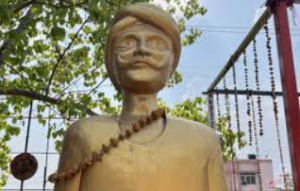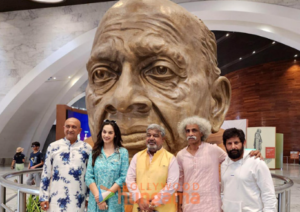Razakar Movie- Silent Genocide of Hyderabad


In the vast tapestry of India’s history, Hyderabad’s story is unique. Nestled in the heart of the Deccan Plateau, Hyderabad was once a princely state known for its rich culture, opulent architecture, and vibrant society. However, its journey was tarnished by disruptive events, particularly during and after the period of independence from British rule. One cinematic endeavour that delves into this complex narrative is the film “Razakar”. Released to critical acclaim, “Razakar” serves as a poignant reminder of the struggles faced by the people of Hyderabad during one of the most turbulent periods in Indian history. Directed by a visionary filmmaker Yata Satyanarayana, the movie entertains and educates, shedding light on the lesser-known aspects of the Hyderabad liberation movement.
Throughout the reign of various empires, people from diverse religious and cultural backgrounds coexisted harmoniously in Hyderabad. Languages such as Sanskrit, Telugu, Kannada, Marathi, Tamil, and Hindi were employed for communication among the populace without discrimination. However, the conquest of Hyderabad by the Bahmani Kingdom resulted in Persian being designated as the official language. Subsequently, the state came under the rule of Sultan Qutb Shahi and later the Mughals.
Following the demise of Aurangzeb and his sons in 1724, Mir Qamar-ud-din Siddiqi, the first Nizam (Asaf Jah I), assumed the role of ‘Subedar’, akin to a provincial governor. He proclaimed Aurangabad as the capital and declared himself king. The second Nizam, Mirza Nizam Ali Khan Siddiqi, relocated the capital to Hyderabad, levied higher taxes on the populace, and initiated diplomatic relations with the British. The fourth Nizam, Mir Farkhunda Ali Khan, integrated his army into the British forces, exacerbating the plight of the people. This trend persisted and worsened until the reign of Mir Tahniyat Ali Khan Siddiqi.

Image source: Google Search Engine
Ramji Gond, a valiant freedom fighter, vehemently opposed the injustices and coined the slogan “जल ज़मीन जंगल” meaning “Water Land Forest”. His courageous stance ignited a revolution among the populace. In response, the Nizam, in alliance with the British Army, orchestrated an assault on Ramji Gond. Subsequently, when individuals dared to vocalise their needs for sustenance, numerous were mercilessly executed by hanging from a single tree. This tree came to be infamously known as the ‘Tree of a Thousand Hangings’. Following this harrowing event, a pervasive fear of the Nizam’s authority enveloped the populace. Recognising the efforts of Ramji Gond and thousands of his followers who bravely sacrificed their lives for their cultural identity, the state BJP president and Union tourism minister, G. Kishan Reddy laid the foundation for Ramji Gond tribal museum in Hyderabad. The Bhartiya Janta Party honours the sacrifices made by Ramji Gond and many of his companions in their efforts to preserve their culture. Such a tribute by a political party like the BJP demonstrates the respect they hold towards the sacrifices of these freedom fighters.
In the era of the sixth Nizam, Mir Mahboob Ali Khan, people experienced a sense of ease and contentment as they pursued their religious practices. Numerous constructions, including buildings, ponds, and other structures, were undertaken, with a concurrent promotion of Hindu religion and culture. Following the passing of the sixth Nizam, Mir Osman Ali Khan ascended as the seventh and final ruler of the Princely State of Hyderabad on August 29, 1911.

Image Source: Google Search Engine
After watching the film and learning about the Seventh Nizam, it seems evident that his primary goal was the promotion of Islam. He converted numerous temples into mosques and compelled approximately 12,000 individuals to convert to Islam through the imposition of an imperial decree. Kasim Razvi, the initiator of the Razakar militia in the region, exceeded all boundaries of extremism by labelling this religious terrorism as Jihad.
The accession of princely states to either India or Pakistan became a critical issue following independence in 1947. While most princely states agreed to join one of the newly established nations, the Nizam chose to let Hyderabad remain independent. Razvi wielded considerable power alongside the Nizam and consistently worked to prevent any potential for joining India.
However, the aftermath of this decision was far from peaceful. The emergence of the Razakars by Kasim Razvi plunged the region into chaos. They sought to convert all residents of the state of Hyderabad to Islam. They employed threats and violence, including killings, against those who refused to comply with their commands.

Image source: YouTube Official Trailer
In the film Razakar, a scene is depicted where a teacher is teaching the Marathi language to his students. At that moment, Kasim Razvi and the Razakars enter, cut the teacher’s tongue, grab his finger, and make him write Urdu on the board using his blood. They threaten him and declare that only their language (Urdu) will be taught in Hyderabad from now on. Not only that, Rizvi and his associates ruthlessly murder all the innocent children present there. This scene was deeply disturbing from within, sending shivers down anyone’s spine and bringing tears to the eyes.
This is just one example among many in the film that deeply affects the viewer. Scenes depicting the coercion of people into adopting Islam as their religion, the heinous acts of raping women and young girls, and the merciless murder of men were portrayed as everyday occurrences. Unfair taxes were imposed on the non-Muslim population, and individuals faced humiliation or even death if they dared to worship their deities. The pervasive atmosphere of fear and violence compelled people to convert to Islam under the threat of death, illustrating the grim realities faced by the populace during that tumultuous period.
During these atrocities, the residents of the state showed remarkable courage in the face of adversity, posing significant challenges to the Razakars. Despite the widespread fear and violence, the people stood resilient, refusing to succumb to the oppressive forces. They bravely resisted the attempts to coerce them into adopting Islam and defended their rights to worship according to their beliefs.

Image Source: Google Search Engine
In the face of persecution, the people of Hyderabad exhibited solidarity and strength, united in their determination to uphold their dignity and freedom. Their unwavering resolve and collective resilience posed formidable obstacles to the Razakars’ oppressive regime, inspiring hope and defiance among the oppressed populace. Through their acts of courage and resistance, the residents of the state demonstrated their unwavering commitment to justice and freedom, leaving a lasting legacy of resilience in the face of tyranny.
The fact that a challenging era has passed and Hyderabad is now a part of India does not change the reality that people are still not free to practice their religion. The case of Mukesh Kumar where he was beaten by some men belonging to the Muslim community for playing Hanuman Chalisa in his shop is an example that shows the state of Hindus in the Congress-led state.

Image source: ANI
To truly appreciate the significance of “Razakar”, it’s essential to understand the historical context in which it is set. During the time when the Nizams governed Hyderabad, the city had some freedom to make its own decisions while still being part of the British Empire. However, when the desire for independence grew stronger across India, Hyderabad’s future became uncertain. The Nizam stopped allowing Indian troops to be stationed in the state, and the acts of violence by the Razakars continued to escalate.
All these issues were troubling the government of India, especially the then Deputy Prime Minister, Sardar Vallabhbhai Patel. He was concerned about the people of Hyderabad, but he was bound by the ‘Standstill Agreement’ of 1947. However, when the atrocities of the Razakars reached their peak, tensions sparked with the Indian government, ultimately leading to the integration of Hyderabad into the Indian Union through a military operation code-named “Operation Polo” in September 1948.

Image source: YouTube Official Trailer
On 31 October 2018, the Government of India unveiled the “Statue of Unity” to commemorate Sardar Vallabhbhai Patel’s efforts in integrating Hyderabad into the Indian Union and liberating its people from the atrocities of the Nizam. Standing at a towering height of 182 meters (597 feet), making it the world’s tallest statue. Located near Kevadia in Gujarat, India, this magnificent monument pays tribute to Patel, a revered statesman and freedom fighter. Patel played a pivotal role in the nation’s political consolidation. Positioned on the banks of the Narmada River in the Kevadiya colony, overlooking the Sardar Sarovar Dam, it stands as a symbol of unity and the indomitable spirit of India.

Razakar team visit to the “Statue of Unity”. Image source: Bollywood Hungama
The film vividly captures the unruly events of this period, portraying the struggles of ordinary people caught in the crossfire of political ambitions and ideological fervour. Through its compelling narrative and powerful performances, the film brings to life the stories of courage, sacrifice, and resilience that defined the Hyderabad liberation movement. One of the film’s most notable achievements is its portrayal of the diverse array of characters who played pivotal roles in shaping the course of history. From the valiant freedom fighters who risked everything for the cause of independence to the ordinary citizens whose lives were upended by violence and upheaval, “Razakar” offers a nuanced portrayal of the human experience amidst political turmoil.
Moreover, “Razakar” doesn’t shy away from exploring the complexities and contradictions inherent in the liberation struggle. It delves into the moral dilemmas faced by individuals torn between loyalty to their homeland and allegiance to a cause they believe in. In doing so, the film challenges simplistic narratives and invites viewers to grapple with the nuances of history. Beyond its historical significance, this film also serves as a powerful commentary on contemporary issues such as identity, belonging, and the legacy of colonialism. By reflecting on the past, the film encourages audiences to confront the lingering echoes of history that continue to shape our present reality.
It is more than just a movie; it’s a testament to the enduring spirit of resilience and resistance that defines the human experience. By shining a light on the struggles of the people of Hyderabad during and after the independence period, the film honours their sacrifices and reaffirms the importance of remembering and learning from the past. In a world grappling with its challenges, it serves as a timely reminder of the power of cinema to illuminate the darkest chapters of history and inspire hope for a better future.
Regrettably, this film is not being shown in many big states and cities’ cinemas in India. In today’s times, where we can easily watch all kinds of movies and entertainment programs, facing difficulties in watching such an important film reflects a mental weakness in society. While on the one hand, we are moving towards modernity, on the other hand, we are part of a society that is not capable of facing the truth.
DISCLAIMER: The author is solely responsible for the views expressed in this article. The author carries the responsibility for citing and/or licensing of images utilized within the text.
